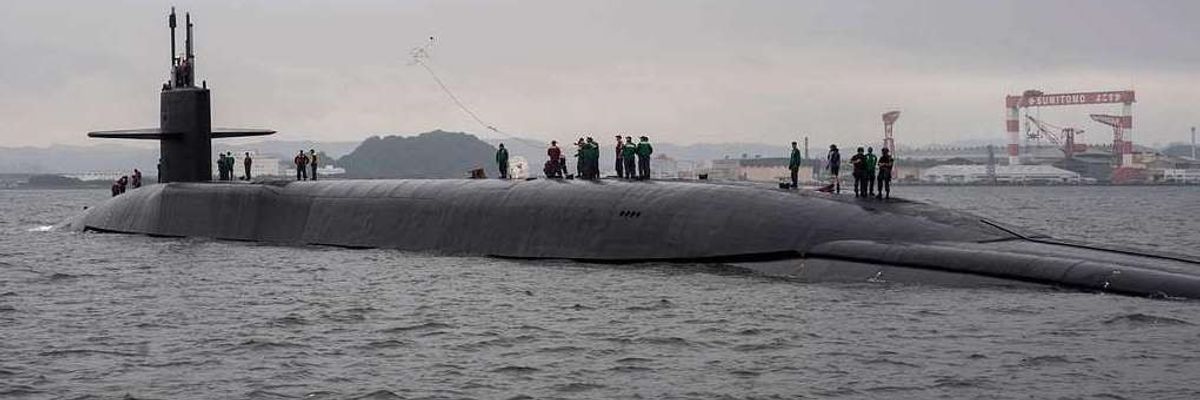The U.S. military-first approach to Asia continued last week as the USS Michigan, a nuclear-powered, guided-missile submarine, arrived in South Korea as part of a new agreement between Washington and Seoul designed to reassure the latter about the strength of the U.S. commitment to its ally.
Following their meeting in April, South Korean President Yoon and President Biden issued the Washington Declaration that restated the American commitment to defend South Korea. Under that agreement the U.S. promised to “enhance the regular visibility of strategic assets to the Korean Peninsula.” The USS Michigan’s visit to South Korea was the first by an American submarine since 2017, and there are likely going to be many more to follow in the coming years.
By itself, this show of force is not necessarily a problem, but a lopsided approach to North Korea and to East Asia more generally that emphasizes military power to the exclusion of other tools cannot reduce tensions or resolve outstanding disputes. The more shows of force that the U.S. makes to reassure South Korea, the more likely it is that North Korea will respond with more of its provocative missile testing and possibly even with a new nuclear test.
U.S. reassurance of allies needs to be balanced with assurances to adversaries, or these gestures of support will stoke tensions and make already dangerous situations more unstable. In that sense, making shows of force can quickly become self-defeating if the U.S. and its allies want to avoid a new crisis.
Unfortunately, there is not much evidence that the U.S. is consistently employing other tools of statecraft to balance the shows of force and military exercises that it has been doing with South Korea and with other allies in the region. The emphasis always seems to be on displaying strength and power projection with little evidence of the flexibility and openness to compromise that are required for de-escalation and diplomatic engagement.
U.S. North Korea policy remains frozen with goals and coercive measures that haven’t made sense or worked for the last 20 years, and on that front there is no sign of a thaw anytime soon. A policy of sticks and more sticks is what brought things to their current state, so we shouldn’t expect to get different results if the policy remains unchanged.
One of the reasons why South Korea demands reassurance is that North Korea’s nuclear arsenal continues to grow unabated, so the best way to address that concern is by working towards an arms control regime that would place limits on the size of the arsenal. The U.S. won’t be able to get North Korea to eliminate its arsenal, but it might be able to secure an agreement that keeps their arsenal under the certain level.
North Korea is already deterred, so it isn’t clear what real benefit the U.S. or South Korea gets from these displays. It’s not as if Pyongyang doesn’t understand how powerful the United States is. After all, their preoccupation with building up a nuclear arsenal is driven in no small part by their fear of an American attack. The U.S. often acts as if our leaders believe that adversaries doubt Washington’s willingness to use force against them, but this is something that other states have no trouble believing. In the North Korean case, their government takes it for granted that the U.S. may use force against them, but they don’t believe promises that it won’t.
Under these circumstances, sending more military assets into the region, even if it is only for a short time, is unlikely to make the situation any better. It is reminiscent of how the U.S. will sometimes fly long-range bombers to the Middle East to “send a message” to Iran, as if the Iranian government had forgotten that the U.S. can attack them. It amounts to little more than saber-rattling that does nothing to address the underlying disputes that could escalate into conflict.
There may be occasions when shows of force are appropriate, but the U.S. should realize that these symbolic gestures can come with real costs when they reinforce mutual hostility and mistrust with adversaries. When other states make overt displays of their military power, the U.S. does not usually view these displays as harmless or defensive actions. Just as the U.S. tends to see such actions by other states as threatening and provocative, the other states see U.S. shows of force in the same way. Combative posturing tends to strengthen hardliners in both governments and makes efforts to reduce tensions much riskier politically.
The submarine visit is intended primarily as a signal to North Korea, but it also sends a message to China, whose government had already denounced the plans for it as soon as the Declaration was published. On this issue, the Chinese Foreign Ministry accused the U.S. of “provoking bloc confrontation, undermining the nuclear non-proliferation system, damaging the strategic interests of other countries, exacerbating tensions on the Korean peninsula, undermining regional peace and stability, and running counter to the goal of the denuclearization of the peninsula.”
The USS Michigan’s visit is bound to antagonize China just as Secretary Blinken was in Beijing to try to stabilize the relationship. Maybe it is a coincidence that the two visits are happening so close to one another, but the timing is hardly optimal.
The U.S. approach to Asia, like much of the rest of our foreign policy, suffers from over-militarization. That has the effect of encouraging arms racing and causing relations with China to deteriorate rapidly, and it creates tensions that many of our allies and partners in the region find worrying.
As international relations scholar Van Jackson observed more than a year ago, “U.S. policy toward the world’s most important region is no more than a mashup of the residual inertia from Trump’s military-first Asia policy with a revival of then-U.S. President Barack Obama’s well-intentioned but ill-fated “pivot to Asia,” which also had a heavily militarized agenda.”
Nothing has happened in the last year to disprove that claim. If anything, the military-first approach has intensified since then. The Biden administration’s most notable initiatives in the Asia-Pacific have all been focused on increased military cooperation and power projection, and there has been nothing comparable in the other areas.
The pitfalls of a military-first approach are not just that it destabilizes Asia, but that it also neglects constructive economic statecraft and diplomatic engagement when these other tools would be both more useful and less costly. Any one part of the military-first approach might seem reasonable enough in isolation, but taken together these things put the U.S. and Asia on a dangerous course that could and should be avoided.
To have a more balanced and constructive approach to Asia, the U.S. needs to deemphasize shows of force and implicit threats to use force and focus its engagement efforts on commerce and diplomacy.
























